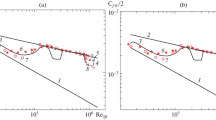Abstract
The dynamic and thermal characteristics of unsteady near-wall flows are investigated numerically on the basis of two-parameter turbulence models under the conditions of high-turbulence free stream and the impact of disturbing blowing (suction) factors in the boundary layer through a permeable surface section. The mutual effect of time harmonic oscillations of the external inviscid stream velocity and the blowing flow rate density on the wall on the development of time-dependent heatand mass-transfer processes in turbulent flow is analyzed. The laws of variation in the flow and heattransfer properties are established when the flow rate density is given to be variable in time and constant. The basic mechanisms of the impact of blowing and suction on the permeable section and downstream are studied by comparing the calculated results.
Similar content being viewed by others
References
Moretti, P.M. and Kays, W.M., Heat transfer to a turbulent boundary-layer with varying freestream velocity and varying surface temperature, an experimental study, Int. J. Heat Mass Transfer, 1965, vol. 8, no. 9, pp. 1187–1202.
Kays, W.M., Heat transfer to the transpired turbulent boundary layer, Int. J. Heat Mass Transfer, 1972, vol. 15, no. 5, pp. 1023–1044.
Simpson, R.L., Moffat, R.J., and Kays, W.M., The turbulent boundary layer on a porous plate: experimental skin friction with variable injection and suction, Int. J. Heat and Mass Transfer, 1969, vol. 12, no 7, pp. 771–789.
Simpson, R.L., Characteristics of turbulent boundary layers at low Reynolds numbers with and without transpiration, J. Fluid Mech., 1970, vol. 42, pt. 4, pp. 783–799.
Simpson, R.L., The effect of a discontinuity in wall blowing on the turbulent incompressible boundary layer, Int. J. Heat and Mass Transfer, 1971, vol. 14, no. 12, pp. 2083–2097.
Andersen, P.S., Kays, W.M., and Moffat, R.J., Experimental results for the transpired turbulent boundary layer in an adverse pressure gradient, J. Fluid Mech., 1975., vol. 69, pt. 2, pp. 353–375.
Aleksin, V.A. and Sovershennyi, V.D., Numerical calculation of a turbulent boundary layer with a sharp change in the boundary conditions, in: Turbulentnye techeniya (Turbulent Flows), Moscow: Nauka, 1977, pp. 55–63.
Aleksin, V.A., Sovershennyi, V.D., and Chikova, S.P., Calculation of the turbulent boundary layer at surfaces with porous sections, Fluid Dynamics, 1978, vol. 13, no. 1, pp. 51–57.
Din, Q.H., Egorov, I.V., and Fedorov, A.V., Mach wave effect on laminar-turbulent transition in supersonic flow over a flat plate, Fluid Dynamics, 2018, vol. 53, no. 5, pp. 690–701.
Gaponov, S.A. and Terekhova, N.M., Joint effect of heat and mass transfer on the compressible boundary layer stability, Fluid Dynamics, 2016, vol. 51, no. 1, pp. 45–55.
Aleksin, V.A., Modelling of the interaction of unsteady high-intensity turbulence flow with heat- and masstransfer in the boundary layer on the surface, Fluid Dynamics, 2018, vol. 53, no. 6, pp. 774–785.
Transition Modelling for Turbomachinery II: An Updated Summ. of ERCOFTAC Trans. SIG Progr. 2nd WORKSHOP, Ed. A.M. Savill, Cambridge: Univ. Press, 1994.
Epik E.Ya. Heat transfer effects in transitions, Proc. On Turbulent Heat Transfer, Engineering Foundation Conf., N.Y.: San Diego California, 1996, pp. 1–47.
Aleksin, V.A. and Kazeykin, S.N., Modeling the effect of freestream turbulence on unsteady boundary layer flow, Fluid Dynamics, 2000, vol. 35, no. 6, pp. 846–857.
Aleksin, V.A., Simulation of the effect of the freestream turbulence parameters on heat transfer in an unsteady boundary layer, Fluid Dynamics, 2003, vol. 38, no. 2, pp. 237–249.
Ginevskii, A.S., Ioselevich, V.A., Kolesnikov, A.V., Lapin, Yu.V., Pilipenko, V.A., and Sekundov, A.N., Methods of calculating the turbulent boundary layer, in: Advances in Science and Engineering. Fluid Mechanics, Moscow: VINITI, 1978, vol. 11, pp. 155–304.
Hanjalic, K. and Launder, B.E., Contribution towards a Reynolds-stress closure for low-Reynolds-number turbulence, J. Fluid Mech., 1976, vol. 74, no. 4, pp. 593–610.
Lushchik, V.G., Pavel’ev, A.A., and Yakubenko, A.E., Turbulent flows. Models and numerical investigations. A review, Fluid Dynamics, 1994, vol. 29, no. 4, pp. 440–457.
Bradshaw, P., Ferris, D.H., and Atwell, N.P., Calculation of boundary layer development using the turbulent energy equation, J. Fluid Mech., 1967, vol. 28, no. 3, pp. 593–616.
Jones, W.P. and Launder, B.E., The calculation of low-Reynolds-number phenomena with a two-equation model of turbulence, Int. J. Heat and Mass Transfer, 1973, vol. 16, no. 6. pp. 1119–1130.
Chien, K.-Y., Predictions of channel and boundary-layer flows with a low-Reynolds-number turbulence model, AIAA J., 1982, vol. 20, no. 1, pp. 33–38.
Abu-Ghannam, B.J. and Shaw, R., Natural transition of boundary layers — the effect of turbulence, pressure gradient, and flow history, J. Mech. Eng. Sci., 1980, vol. 22, no. 5, pp. 213–228.
Aleksin, V.A. and Kudryakov, A.M., Unsteady periodic boundary layer with backflow zones, Fluid Dynamics, 1991, vol. 26, no. 5, pp. 703–711.
Cebeci, T., Calculation of unsteady two-dimensional laminar and turbulent boundary layers with fluctuations in external velocity, Proc. Roy. Soc. London. Ser. A, 1977, vol. 355, no. 1681, pp. 225–238.
Karlsson, S.K.F., An unsteady turbulent boundary layer, J. Fluid Mech., 1959, vol. 5, pt 4. pp. 622–636.
Funding
The investigation was carried out in accordance with the theme no. AAAA-A17-117021310376-4.
Author information
Authors and Affiliations
Corresponding author
Additional information
Russian Text © The Author(s), 2019, published in Izvestiya RAN. Mekhanika Zhidkosti i Gaza, 2019, No. 6, pp. 60–74.
Rights and permissions
About this article
Cite this article
Aleksin, V.A. Numerical Simulation of the Interaction of Unsteady Surface Blowing (Suction) with Turbulent Near-Wall Flow. Fluid Dyn 54, 797–811 (2019). https://doi.org/10.1134/S0015462819060016
Received:
Revised:
Accepted:
Published:
Issue Date:
DOI: https://doi.org/10.1134/S0015462819060016




